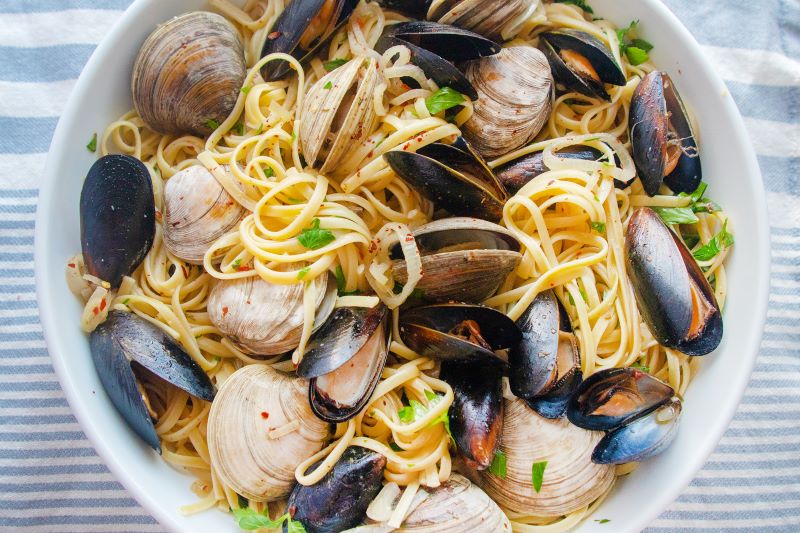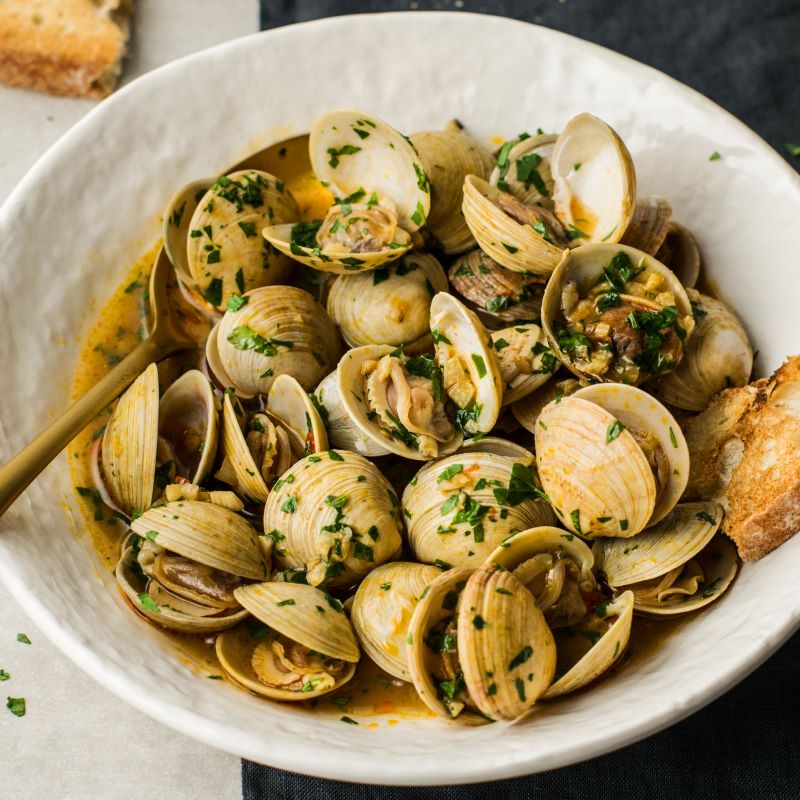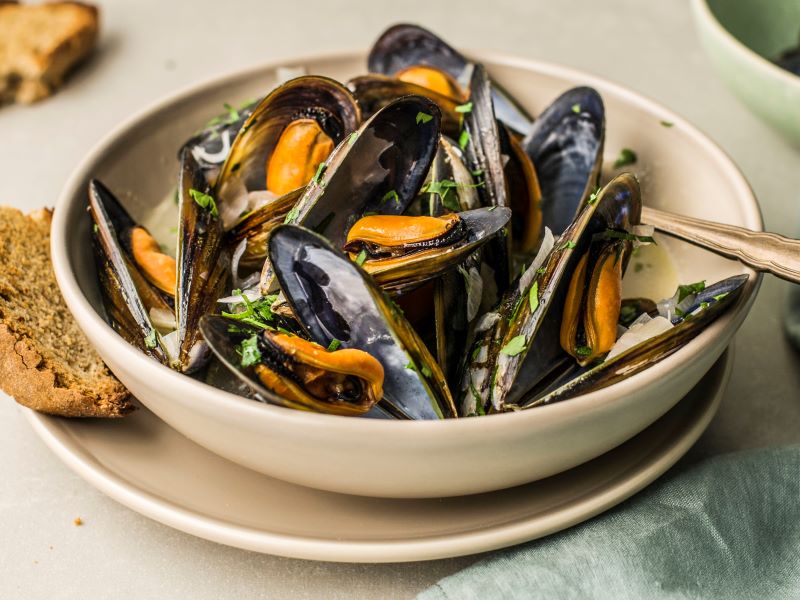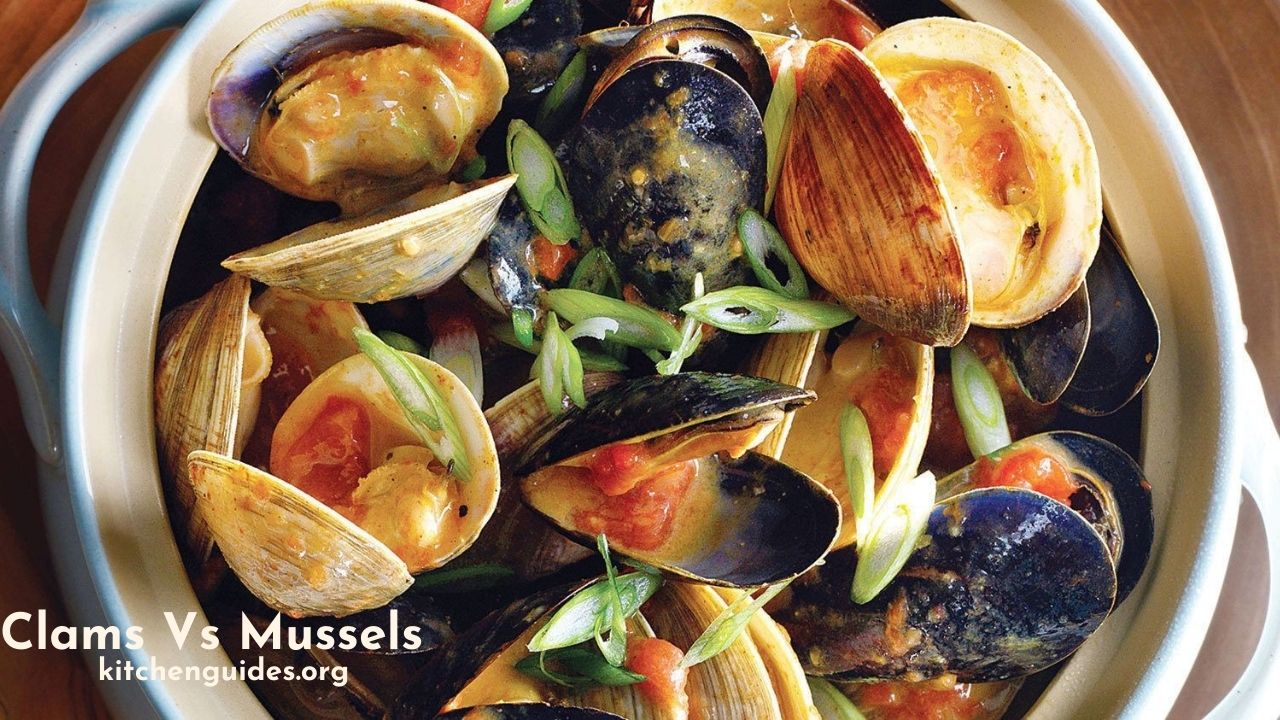Clams Vs Mussels. There are many things to consider when it comes to cooking clams and mussels. Which are much better? Let’s talk about clams and mussels. They are easy to confuse. Let’s clear this up!
Clams: What is it?
Clams are a type of bivalve mollusk, meaning they have two shells. They are related to oysters, mussels, and scallops.
Clams live in the ocean and coastal areas around the world. They feed on plankton and other tiny organisms in their environment.
There are many different types of clams, but most people know about two main types:
- Hardshell clams (aka hard shell clams)
- Softshell clams (aka soft shell clams).
Mussels: What is it?
Mussels are bivalve mollusks that have a firm shell and a soft body. They can be found in oceans, lakes, and rivers. They are also commonly called clams.
Mussel shells are made up of calcium carbonate (a mineral) and are usually brown or black. Mussel shells have two parts:
- The lower shell
- The upper shell.
Both parts are called valves. The hinge is where the two valves meet together. A mussel’s foot is used to attach itself to rocks or other surfaces so it doesn’t get washed away by waves and currents in the water.
A Comparison Of Clams Vs Mussels.

Clams and mussels are two types of bivalves. They are both edible and have similar nutritional values. They can be prepared in the same way, and they have a similar taste.
However, there are differences between them that you should know about before you make your choice.
1. Habitat
Clams and mussels have different habitats in the wild.
Clams are found on rocky bottoms or mudflats along the shoreline.
Mussels live attached to hard substrates like rocks, pilings, and other surfaces in the water column.
2. Shell
Mussels: Mussels have a pointed shape with a flatter bottom shell than a top shell. Mussels have a thick muscle called an adductor muscle that pulls the shells together so they can’t open fully. This allows them to hold on to rocks or other surfaces with their byssus threads (a sort of fuzzy rope).
Clams: Clams have a slightly rounded shape with a more rounded bottom shell than a top shell. Clams don’t have an adductor muscle like mussels do, so they can open fully if they want to.
3. Size
Clams tend to be larger than mussels.
A large clam can be up to 10 inches in diameter.
A large mussel is typically no more than 2 or 3 inches wide.
4. Diet
Clams and mussels have similar diets, but clams tend to live in shallow water while mussels prefer deeper water.
The diet of clams includes algae, plankton, and detritus (dead organic matter).
The diet of mussels includes algae, detritus, and diatoms (algae that live inside a shell-like casing).
5. Taste
Mussels have a milder flavor than clams. They can be eaten raw or cooked, but they taste better when cooked because they absorb less water when boiled than clams do.
Clams have a more robust flavor than mussels because they are usually eaten raw on the half shell with just a little lemon juice or hot sauce on them (if at all). Clams can also be steamed open in their shells, which makes them easier to eat if you don’t like them raw.
6. Appearance
Clams are smaller than mussels and have two hinged shells that close together over their soft bodies when the clam retracts its foot into its shell for protection.
Mussels have one shell that opens and closes like a book over their soft bodies when they retract their foot into their shell for protection from predators.
7. Cooking technique
One of the biggest differences in the way they’re cooked:
Mussels can be steamed.
Clams need to be steamed or boiled.
Clams also have a thicker shell than mussels and are usually larger than mussels.
8. Nutrition
Clams and mussels are both shellfish that are popular in the culinary world. They are both low in calories, with clams having slightly more protein than mussels. Both have a high content of omega-3 fatty acids and vitamin B12.
Clams also contain high levels of selenium, which is an antioxidant mineral that prevents damage from free radicals. According to the National Institutes of Health, selenium can reduce your risk for certain cancers and heart disease. A serving of clams contains about 26 percent of your daily requirement for selenium, but only 14 percent of your daily requirement for vitamin B12.
Mussels have similar levels of selenium as clams, but they are higher in vitamin B12 than clams. They also have more protein per serving than clams do — five grams compared to four grams per serving — so mussels might be a better choice if you’re looking for something to eat as an afternoon snack or before bedtime because they’ll keep you full longer than one serving of clams might do.
9. Life cycle
Clams and mussels live in saltwater environments where they feed on algae. They are filter feeders, which means they use a specialized mouth that filters water for food.
Clams are stationary animals; they don’t move around much, but they can close their shells tightly to protect themselves from predators.
Mussels have a more active lifestyle because they are able to move around.
Simple Steamed Clams And Mussels Recipe

Clams and mussels are a wonderful addition to any meal. We love them steamed in a pot with a few other ingredients, but they also make a delicious appetizer when served cold with a creamy dipping sauce.
About Clams

In this recipe, we’re going to show you how to make steamed Clams using just a few ingredients. We’ll also give you some tips on how to store them so that they stay fresh for days after you’ve cooked them.
Ingredients:
- 25 clams, scrubbed clean and purged of mud (about 1 pound)
- 1/2 cup white wine or water
- 1 lemon, sliced into thin wheels
- 3 tablespoons minced fresh parsley
- Salt and freshly ground black pepper to taste
Directions:
Step 1: Heat a large pot over medium heat. Add the oil, garlic, onion, and celery and saute until tender, about 5 minutes. Add the wine or water and bring to a boil.
Step 2: Add the clams cover tightly with a lid, and steam until they open for about 5 minutes. Remove from heat immediately. Remove clams from shells; discard shells, but do not chop meat.
Step 3: Spoon the clam meat into 4 serving bowls; top with lemon wedges and parsley sprigs.
Step 4: Season with salt and pepper before serving immediately
About Mussels

Steamed mussels are a classic French dish, and they’re easy to make at home. It’s best to buy fresh mussels, but you can also use frozen ones if you can’t find any fresh ones.
Ingredients:
- 1 tablespoon unsalted butter
- 2 pounds mussels, scrubbed and debearded (about 20)
- 1/4 cup dry white wine
- 2 tablespoons minced shallots or onion
- 1/2 cup heavy cream or half-and-half, plus more for serving (optional)
- Salt and freshly ground black pepper to taste
Directions:
Step 1: Heat the butter in a large pot over medium-high heat. Add the mussels and stir just until they begin to open up about 2 minutes.
Step 2: Add the wine, shallots or onion, and cream or half-and-half, cover, and steam for about 8 minutes, stirring once or twice during that time. Season with salt and pepper to taste.
Step 3: Ladle into warmed bowls and serve immediately with additional cream or half-and-half if desired
FAQs
1. Are clams and mussels the same thing?
No. Clams are a type of bivalve mollusk, while mussels are another type of bivalve mollusk. They’re both shellfish that you eat by opening their shells, but that’s where the similarity ends.
2. Are clams and mussels interchangeable in recipes?
Not really. Both have similar flavors, but they’re not interchangeable in recipes or on the plate. You can use either clam or mussel meat in chowders, stews, and other dishes where you want to add seafood flavor without having to deal with removing the meat from its shell first. But they don’t taste exactly alike. If you’re making something like a chowder or stew that needs seafood flavor but doesn’t require an exact amount of clam or mussel meat, it’s best to just use one or the other (or both) rather than trying to substitute one for the other in any recipe that has specific amounts noted in its recipe instructions.
3. What’s the best way to store clams and mussels?
Keeping your mollusks cold is key to preserving their freshness and preventing spoilage. Try storing your mollusks in an ice chest with a wet towel draped over it — this will keep them cool without getting soggy (or at least keep them from getting too soggy). If you’re going to be using your clams or mussels soon after buying them, you can freeze them for up to a month before cooking them — just make sure not to freeze your clams or mussels with any other ingredients like lemon or butter that could melt into the water when thawing out!
4. Where do clams vs mussels live?
Mussels live in rivers, lakes, and other freshwater areas. They stick themselves to rocks or other hard surfaces by using strong threads called byssal threads which are made out of mucus that comes out from their foot (see picture below).
Clams live in saltwater areas such as oceans or estuaries, where they attach themselves to rocks or other hard surfaces with their foot.
5. Can you eat clams, mussels, and oysters raw?
Yes. All three of these seafood are perfectly safe to consume raw. You can enjoy them in sushi rolls or with other dishes that call for cooked seafood.
6. Is it true that clams and mussels have a lot of cholesterol?
Yes, clams and mussels contain high levels of cholesterol. However, consuming them in moderation won’t raise your risk of heart disease or stroke. The American Heart Association recommends eating no more than two servings (3 ounces) per week if you have heart disease or one serving if you don’t.
In Conclusion
In the end, there is no clear winner between clams and mussels. Both of these products are difficult to get in fresh form, with the former being more readily available because of their long shelf-life. So which product is better? Or is there even a true “winner?” It ultimately depends on your needs and preferences as a consumer.
